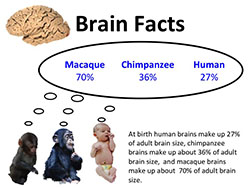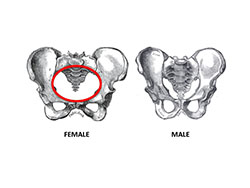
Babies, Birth, and Brains
Big-headed humans
If you have seen baby pictures of yourself, you probably noticed that your head was large compared to the rest of your body. It was probably much larger in comparison to your body than it is now. Even so, your head was pretty small compared to its current size.
The reason for this is that brains, just like all other organs, must grow to reach their adult size. Organs can grow at different rates: they can grow fast or slow. If growth occurs quickly, then an adult size is reached at a younger age. If growth occurs slowly, on the other hand, then adult size is reached at an older age.
For the brain, slow growth means a longer time to absorb information. This is important for us because we are an intelligent and social species. The ways in which our brains grow allow us to learn the social information needed to live in our societies. Scientists look at how human brain size and growth differ from other animals. They do this to find out when these differences arose during our evolution. This information allows us to know what makes us human and when we became that way.
 Primates are the group of mammals to which humans belong. Primates have larger brains than other mammals. Because of this, primate moms give birth to large-brained babies. Among primates though, human brains are the largest. Because of this, human moms give birth to the largest-brained primate babies. Human brains are so large at birth that babies cannot support their own heads for the first few months of life. Our brains need to be that large at birth to grow into the large adult brain.
Primates are the group of mammals to which humans belong. Primates have larger brains than other mammals. Because of this, primate moms give birth to large-brained babies. Among primates though, human brains are the largest. Because of this, human moms give birth to the largest-brained primate babies. Human brains are so large at birth that babies cannot support their own heads for the first few months of life. Our brains need to be that large at birth to grow into the large adult brain.
Even though human brains are large at birth, they only make up about 27 percent of adult brain size. Let’s compare that to some of our close relatives, other primates. Chimpanzees, our closest living relatives, are born with about 36 percent of their adult brain size. Macaques are a bit more distantly related to us. They are born with about 70 percent of adult brain size. Because we grow larger brains than other primates, humans must also grow a larger percentage of our adult brain size outside the womb.
 In humans, the fastest rate of brain growth occurs during the nine months before birth. Once a baby is born, brain growth begins to slow down, but it still proceeds at a relatively fast rate for the first few years of life. In modern humans, adult brain size is reached at around age 12, but the structure continues to mature (i.e., connections continue to be made between brain cells) for many years.
In humans, the fastest rate of brain growth occurs during the nine months before birth. Once a baby is born, brain growth begins to slow down, but it still proceeds at a relatively fast rate for the first few years of life. In modern humans, adult brain size is reached at around age 12, but the structure continues to mature (i.e., connections continue to be made between brain cells) for many years.
Chimpanzee brains grow at a slower rate than human brains. Chimpanzee brains are also about one-third the size of human brains. Because of these two factors, chimpanzee brains reach adult size at around age six, which is much younger than in humans.
How big can a brain get?
 Although brains grow quickly in the womb, there is a limit to how big a brain can be at the time that a baby is born. Brain size at birth is limited by the size of the mother’s hip bones. At the time of birth, the head is the widest part of the baby. The head has to pass through the passageway formed by the hip bones of the mother. This passageway is known as the birth canal. If the baby’s head is too large for the birth canal, the baby cannot be born. As a result, the hip bones of humans are wide, and the hip bones of females are wider than those of males.
Although brains grow quickly in the womb, there is a limit to how big a brain can be at the time that a baby is born. Brain size at birth is limited by the size of the mother’s hip bones. At the time of birth, the head is the widest part of the baby. The head has to pass through the passageway formed by the hip bones of the mother. This passageway is known as the birth canal. If the baby’s head is too large for the birth canal, the baby cannot be born. As a result, the hip bones of humans are wide, and the hip bones of females are wider than those of males.
Bibliographic Details
- Article: Babies, Birth, and Brains
- Author(s): Halszka Glowacka
- Publisher: Arizona State University Institute of Human Origins Ask An Anthropologist
- Site name: ASU - Ask An Anthropologist
- Date published:
- Date modified:
- Date accessed: January 3, 2025
- Link: https://askananthropologist.asu.edu/stories/babies-birth-and-brains
APA Style
Halszka Glowacka. (). Babies, Birth, and Brains. Retrieved 2025, Jan 3, from {{ view_node }}
American Psychological Association, 6th ed., 2nd printing, 2009.
For more info, see the
APA citation guide.
Chicago Manual of Style
Halszka Glowacka. "Babies, Birth, and Brains." ASU - Ask An Anthropologist. Published . Last modified . https://askananthropologist.asu.edu/stories/babies-birth-and-brains.
Chicago Manual of Style, 17th ed., 2017.
For more info, see the
Chicago Manual citation guide.
MLA Style
Halszka Glowacka. Babies, Birth, and Brains. ASU - Ask An Anthropologist. , {{ view_node }}. Accessed January 3, 2025.
Modern Language Association, 8th ed., 2016.
For more info, see the
MLA citation guide.

Learn more about the parts of the brain and what they do at Ask A Biologist's story A Nervous Journey.
Be Part of
Ask An Anthropologist
By volunteering, or simply sending us feedback on the site. Scientists, teachers, writers, illustrators, and translators are all important to the program. If you are interested in helping with the website we have a volunteers page to get the process started.
